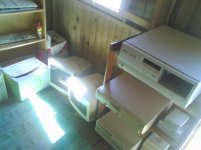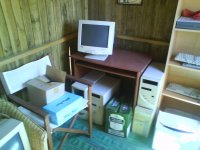I'd help you if you were nearby, but unfortunately Portugal is a ways from DE, USA, heh. I have books on building 1992-1995 era machines, but they really aren't too difficult. There is little difference between assembling a modern PC and a vintage one, at least of this vintage. Here's some basics:
The card slots:
- The white shorter slots are "PCI".
- The black long slots are "ISA" (every once and a while these are white).
- The black short slots are 8-bit "ISA".
- The black long slots with a brown section at the end are "VESA".
- The brown long slots that look very similar to ISA are "EISA", you aren't likely going to run into these.
- The brown slots that don't look like ISA are probably "MCA" - this is predominantly found in IBM machines.
Any machine that predates a 486 will have a plain socket or soldered-on CPU. "LIF" sockets, as they're called, require you to place a CPU on top of them, lining the pins up with the holes, and then pushing until it feels firmly seated.
Any machine with a Socket 3 (later 486) and newer requires you to pull a lever up, place the CPU in, and then push the lever back down. This is the same as a modern CPU insertion.
Any CPU that predates the 486 does not require a heatsink or fan unless it came with one attached. Any 486 that requires a heatsink or fan will either have one attached to it permanently, or say that it requires one on the chip itself.
When connecting the power cables to an AT motherboard (anything that has the big keyboard connector and the clicky power switches that toggle on and off) there are two connectors that sit side by side known as "P8" and "P9" - always be sure to insert them right, or you can fry the machine. The ground wires (almost always black) should meet in the middle.
To power devices, molex connectors are used. These are the four-pin connectors coming out of the power supply. They are shaped such that you can't insert them wrong, so just make sure each device (HDD, CDROM, etc.) has one inserted. 3.5" floppy drives and a few other devices use "mini" molex, which is the same but smaller - you should also find some of these coming out of the power supply.
Be sure that the voltage switch on the back of any power supply you use is set to the right voltage. I'm not sure what the AC lines have in Portugal, but here in the US it's "115", and in the UK it's "240". I'd bet 240 in your case, but I don't know. Setting this wrong can also kill a machine, but usually you'll end up with all power supplies you obtain set properly - unless you import machines.
There are four types of RAM you'll see with vintage machines.
The first is "SRAM" and it's basically little black chips plugged into sockets or soldered onto the motherboard. This is what's used in most pre-386 machines.
In late 286 and most 386 machines, you'll find 30-pin SIMMs. SIMMs are your typical "RAM stick" but very small. To install these you set them in the socket vertically, then tip them over until they click into place. You can only insert these one way, so careful not to jam them in wrong.
In late 386 and most 486 machines, as well as some Pentiums, you will find 72-pin SIMMs. These are the same as the 30-pin variety, but larger and with higher capacities. There are some caviats in which a machine can only want certain sizes or types of this RAM, so if you run into trouble just ask.
In most Pentiums and all later machines you will find "DIMMs", which are similar to SIMMs in appearance, but far larger. These have a notch in the bottom making it so that you can't insert them wrong or into the wrong type of board (there are many sorts of DIMM for different eras). They are still used in modern machines. These are inserted by lining them up with the socket, setting it into the socket, then applying force to each or both ends until the little grip things on the sides snap inward and lock the stick into place.
Finally there are cables that go from the case to the motherboard on ATX systems (late Pentium and newer), but that's specific to each motherboard and case, so I can't really give much explanation. On the bright side, AT systems don't have this headache.
I think that's all you should need to know to get started, but if you run into any questions feel free to ask.
No idea why I felt like writing that all out, but enjoy, heh. :D
Edit: I forgot to talk about data cables. In vintage machines there are three types - MFM, IDE, and floppy. These are all ribbon cables. MFM (or RLL) are for old HDDs, and they use a small ribbon and a large ribbon, the smaller one is for data and the larger one (looks almost identical to an older floppy cable) is for control.
IDE is more common in the era of system's you're working on, and is a 40-pin (later 80-pin for higher speed drives/controllers) ribbon that you must be careful to line up the red line (denoting the first pin) with the correct part of the thing you're plugging it into.
The floppy cable works the same was as the IDE cable, but older floppy cables can also have card-edge connectors that can only be inserted one way. If your cable has both, know that that doesn't mean you can plug in four drives - it means you can choose one from each pair of connectors depending on what you need.
It's odd - once I started going my mind just spat out information like a textbook, lol.



